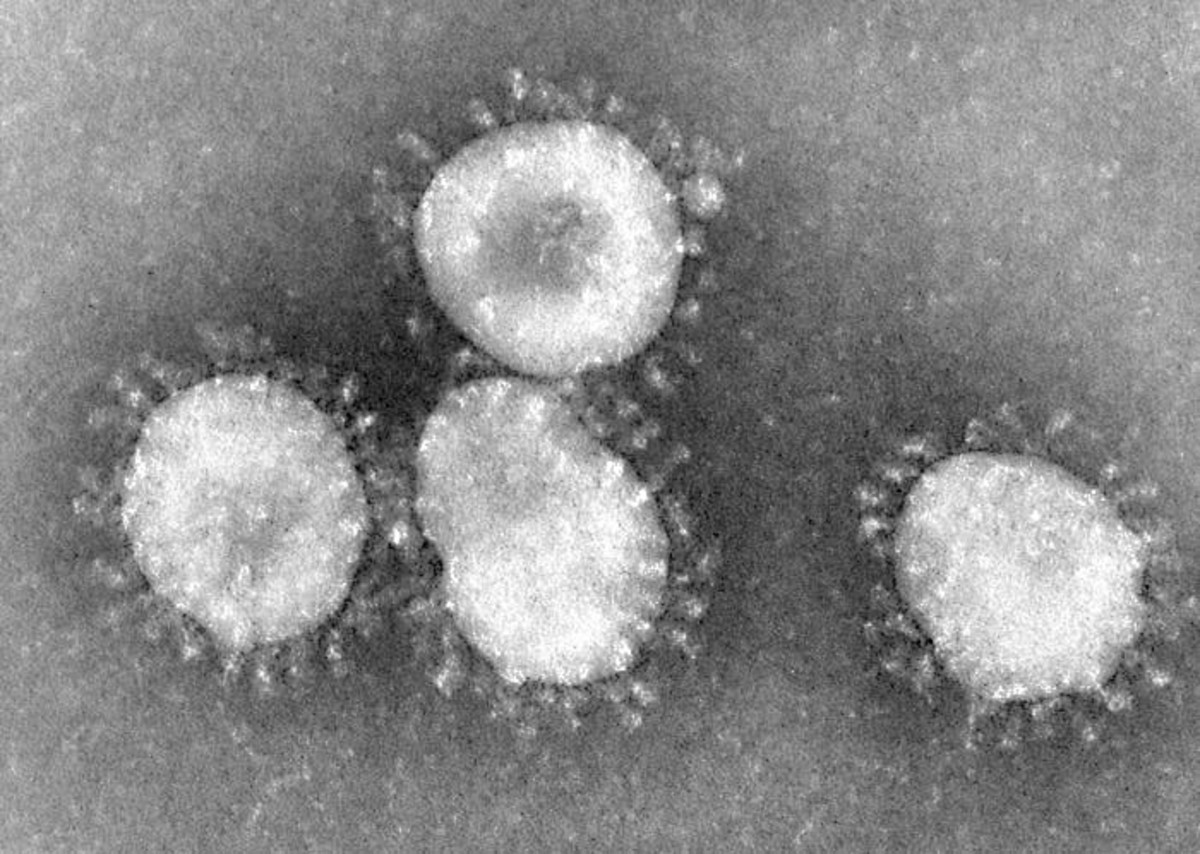Learning About Viruses and Bacteria
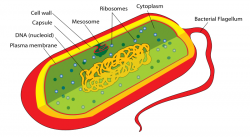
What Are Viruses and Bacteria?
Although both can make us sick, viruses and bacteria are very different things.
Viruses are not living organisms. Viruses are simply genetic material (RNA or DNA) covered with a protective protein coat. Viruses can not reproduce on their own. Viruses must enter a host cell in order to reproduce.
Bacteria are simple, single celled organisms. Bacteria can reproduce on their own. Bacteria are living things.
On this page we'll explore some of the similarities and difference between viruses and bacteria, as well as learn a bit more about both.
Are you a student studying biology? This page on viruses and bacteria is one of series of pages on biology topics. Links to the other pages in the series can be found near the bottom of the page.
The image shown above is of a type of bacteria cell.
Are viruses and bacteria alive?
Do they have the 7 characteristics of life?
Back in unit one, we explored the properties of life. Do you remember them? If not, take a quick glance at: 7 Properties of Life.
One of the properties of life is the ability to reproduce. Bacteria can reproduce, and meets the other 6 properties of life as well. Bacteria are alive.
Viruses, on the other hand, are not able to reproduce on their own. In order for a virus to reproduce, it must enter into a host cell and use the host cell's reproductive abilities. So viruses are not really living things. They don't have all the characteristics of living things. In fact, in addition to not being able to reproduce on their own, they also do not eat or make their own food. They do not grow and develop. Nor do they work toward maintaining homeostasis (maintaining a constant internal environment).
Virus means "poison"
in Latin.
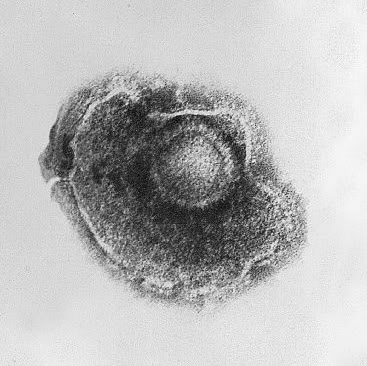
Viruses contain either RNA or DNA
RNA and DNA are genetic material - the stuff that allows a virus to spread. Viruses contain either RNA or DNA - not both.
A virus is like a little pocket of genetic material. Viruses with RNA (genetic material) in them include HIV, influenza, hepatitis C, polio, severe acute respiratory syndrome, and rabies. Viruses with DNA in them include chickenpox, mono, and warts. It is more difficult to make vaccines against RNA viruses because of their high mutation rates.
Shown here is the Chickenpox virus.
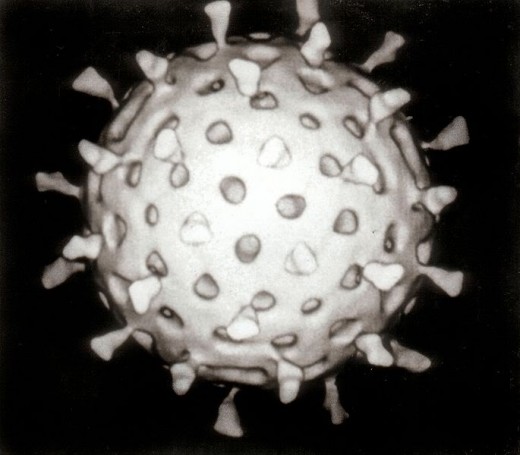
Viruses come in many shapes
This is a picture of the Rotavirus. It has a spherical shape.
Rotavirus is a virus that causes a "stomach bug" with vomiting, diarrhea, and fever. The virus infects the cells that line the small intestine.
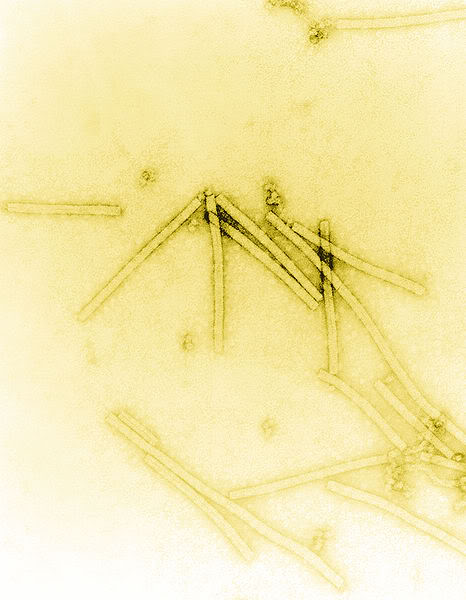
Shown here is an image of the Tobacco Mosaic Virus. It has a rod-like shape.
The Tobacco Mosaic Virus infects plants, especially tobacco plants.
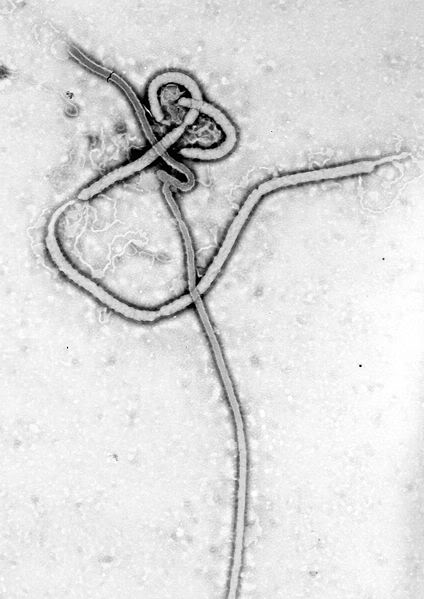
The Ebola Virus has a shape resembling cooked spaghetti noodles.
This virus, which affects humans and other primates, is acquired through contact with blood or other fluids from an infected animal.
The Ebola Virus primary affects people living in tropical areas, such as Africa.
Efforts are underway to develop a vaccine for this serious virus.
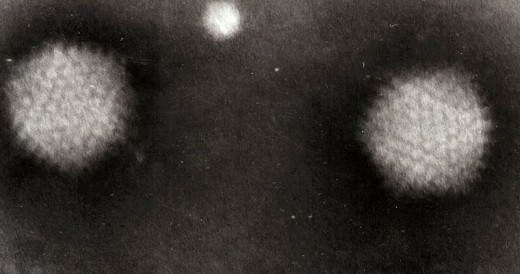
Shown here is the Adenovirus. It's a Polyhedral, which means it has many sides.
The Adenovirus can cause anything from a mild respiratory infection to a multi-organ affected disease which is life threatening.
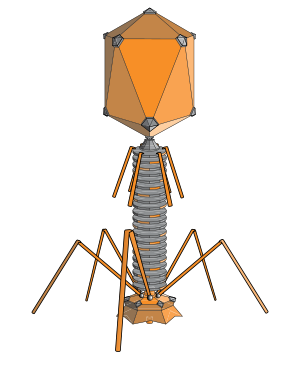
This is a Bacteriophage. It's a virus that attacks a bacteria.
To me, it looks like some sort of robot or landing apparatus for the moon!
Viruses Multiply Within A Host Cell
Viruses multiply in a living thing by infecting its cells and then using the cell to to make more of the virus.
Here are some youtube videos about viruses!
I really like this youtube on the Virus Entry System. It provides a computerized demonstration of how a virus tricks its way into a cell and makes more viruses which then burst out of the cell.
The Virus Entry System
Viral Replication is another one of Mr. Paul Anderson's Bozemanbiology biology youtubes. In it, he explains how viruses reproduce using the lytic cycle. Also covered are the lysogenic cycle, and how retroviruses (like HIV) can enter into the lytic cycle.
Viral Replication
How the HIV virus infects healthy cells
Emerging Viruses
Emerging Viruses are viruses that are either new or are now appearing in an area where they haven't been appearing (such as when a virus that is common in one part of the world gets spread to another part of the world).
An example of an emerging virus in the US is the West Nile virus, which began to be spread across the US in 1999. The virus is common in Africa, parts of Europe, and western Asia. The West Nile virus probably spread overseas via an infected bird. The virus is spread through mosquito bites, and causes flu-like symptoms. It can very serious in the elderly, leading to possible brain inflammation.
Bacteria
Bacteria
Bacteria are unicellular prokayrotic cells in the Eubacteria or Archaebacteria Kingdoms
Bacteria are unicellular organisms that can reproduce on their own. They are also prokaryotic, which means they are simple cells without a nucleus and without most cell organelles. (Eukaryotic cells have a nucleus and cell organelles.)
Unlike eukaryotes, bacteria:
*are much smaller (with some exceptions)
*often lack cell compartmentalization
*have a single piece of DNA that's arranged in a circle
*reproduce by binary fission
*have simple flagella that spin or pili (short thick outgrowths that allow bacteria to attach to things)
*can engage in several kinds of anaerobic processes
What Is Bacteria?
Like Viruses, Bacteria Come In Many Shapes

Like Viruses, Bacteria Come In Many Shapes
Just like viruses, Bacteria come in many shapes. These include spherical, rod shaped, and spiral (which are sometimes more like commas or squiggly snakes).
Shown here is a Spirillum Bacteria, which has a spiral or curvy shape.
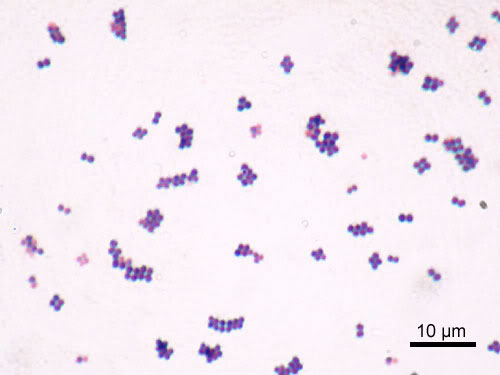
Staphylococcus bacteria have a spherical shape. They are the cause of Staph infections, including pneumonia, skin infections, Toxic Shock Syndrome, blood poisoning, and food poisoning.
Keeping your hands clean, and washing any cuts you may get, helps to prevent Staph infections of the skin.
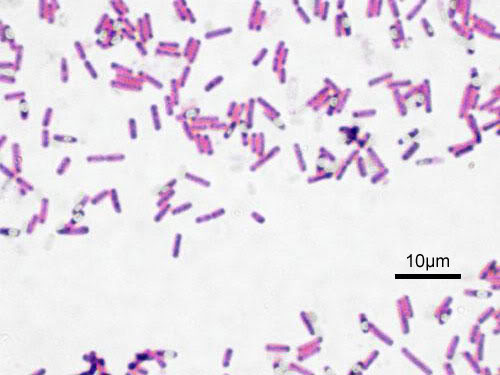
The Bacillus bacteria has a rod shape. One form of it causes anthrax, while another form of it causes food poisoning.
How Bacteria Obtain Energy - Types of Bacteria
- Photosynthesis - Some bacteria engage in photosynthesis and can have one of four types of photosynthetic pigments, categorizing the bacteria into four groups: purple nonsulfur bacteria, green sulfur bacteria, purple sulfur bacteria, and cyanobacteria.
- Chemoautotrophs - Some autotrophic bacteria get their energy from inorganic molecules (like ammonia) or organic molecules (like methane), rather than by photosynthesis.
- Hetererotrophs - Most bacteria get their energy by decomposing the bodies of dead organisms.
Bacteria: Staph, Strep, Clostridium, and Other Bacteria - A Class of Their Own series
The "A Class of Their Own" series examine the 6 different biological classes: animals, plants, bacteria,fungi, archaea, and protists.
If you are interested in finding out more about bacteria, you may want to read Bacteria, Staph, Strep, Clostridium, and Other Bacteria. This book on bacteria looks at the bacteria that are found in almost every environment (such as extreme heat or cold), including that of the human body.
Bacteria Resources
- Bacteria Lab
This is a bacteria lab in which you grow bacteria in petri dishes. - Another Bacteria Lab
This one is similar to the lab above.
Comments?
There's a guestbook at the bottom of this page for those who would like to leave a comment!
© 2012 JanieceTobey




